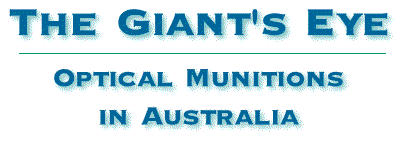

In 1939 the simple glass lens was described as 'the giant's eye of modern mechanised warfare, without which armies would be practically blind.'(1)Binoculars, cameras, bomb and gun sights are just some of the optical munitions - or military optical devices - that are required by defence forces to fight a war.
At the outbreak of the Second World War, Australia recommenced manufacturing its own weapons, but just as they began to roll off the production line it was realised that the gunsights promised from Great Britain were not coming. At that time, Great Britain was the only supplier of optical munitions to Australia, and there was no Australian precision optical industry to fill the gap. What was to be done? Our soldiers had to see their enemy to be able to fight and survive!
Professor Laby, the president of the Australian Branch of the British Institute of Physics at that time, offered the help of Australian physicists. The Optical Munitions Panel (OMP) was established at a meeting of interested physicists and politicians in June 1940. Laby was appointed Chairman, and physicists from all over Australia were invited to join the war effort.
There were considerable obstacles facing the OMP: there was no local supply of optical glass; there were few workers skilled to work the glass into lenses and prisms; and they had little of the required equipment. Dependent on overseas sources for so long, Australia was really starting from scratch.
The British estimated it would take Australia four years and cost £1 million to produce its own optical glass. However, they had not counted on the determination and ability of our scientists. Professor Ernst Hartung, from the University of Melbourne, worked in conjunction with ACI in Sydney and produced the first sample of Australian-made optical glass just six months later! The estimated cost to the Australian Government was only about £68,000 - a fraction of the rather pessimistic British estimates.
Once the OMP had proved that Australia could manufacture its own optical glass, it needed to create an Australian precision optical industry and specially train workers for the task. Scientists, technical workers, students, and even a number of war internees - men and women alike were gathered to the OMP. Many of them remained in this industry at the end of the war.
The University of Melbourne, Mount Stromlo Observatory (in those days known as the Commonwealth Solar Observatory), and the Waterworth Optical Annexe in Hobart are just a few organisations that made enormous contributions to Australia's optical munitions war effort. No fewer than twenty-five firms, laboratories and Australian university physics departments were involved in wartime optical munitions projects. In total, forty-three different types of optical instruments were designed and made in Australia, and over 26,000 items were produced.
(1) H.C. McKay, 'Magic eyes of war and peace', Smith's Weekly, 18 November 1939, p. 13.